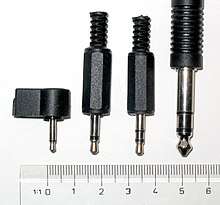Microphone connector
Many different electrical connectors have been used to connect microphones to audio equipment—including PA systems, radios, tape recorders, and numerous other devices.
Phone connectors

The most common microphone connector in consumer use is the venerable phone connector, in 1/4" (6.35 mm), 3.5 mm, and 2.5 mm sizes, and in both mono and stereo configurations.
Not all microphone plugs with 3-segment TRS (Tip-Ring-Sleeve) connectors are actually stereo. Most computer microphones use the third segment to carry bias power for the microphone.
SwitchCraft 2501F
This is the part number for a Swichcraft connector used with high impedance microphones up through about 1980. It was intended for coax style cable up to 0.281 inches (7.1 mm) outside diameter.
Attachment is made with a 5/8-27 threaded ring that can be unthreaded over the body of the connector body allowing the female connector to become a male connector.
Wire connection was via solder. The center conductor is soldered to a hole resulting in a flat center contact. The cable shield is soldered to the strain-relief spring which is held in the body of the connector with a set screw.
With no provision for spring loading of the connection ring, vibration tends to loosen the threaded ring an create intermittent contact.
Amphenol 80-series and 91-Series
Popular microphone connector from 1930s to 1980s, original manufactured by Amphenol. Amphenol sold this production to WPI Interconnect in early 1980s.
XLR connectors
Most commonly used on professional microphones, the common 3-pin XLR connector is a standard for transferring balanced audio among professional audio equipment.
The 4-pin XLR connector is also commonly used on amateur radio microphones, but transferring unbalanced audio instead, and using the 4th pin (with the common ground) for a push-to-talk (PTT) circuit activated by a button on the microphone. Some broadcast radio professionals also use these microphones, instead using the PTT circuit as a cough button (a momentary mute button) so that they may cough, clear their throat, or make comments to others in the studio without the sounds being broadcast.
Multi-pin circular connectors (CBC-series, Foster)
First used in the 1970s by Japanese radio manufacturers, for microphone connectors on Citizens Band and amateur radio equipment, these screw-on circular connectors were available with 2, 3, 4, 5, 6, 7, or 8 pins. They often were used for other purposes as well, such as 1970s amateur radio transceivers (microphone), 1970s Kenwood mobile radios (2-pin, DC power), Eastern Asian built soldering stations in 1990s.[1]
These screw-locked connectors can be hard to find as they come under many generic names: "CB connector", "Mobile connector", "Microphone connector", "Power connector"—even sometimes misidentified as XLR connectors.
Even though this circular connector was largely standardized, there was no industry standard for pin assignments. Pin assignments to specific functions varied from manufacturer to manufacturer. For example, in amateur radio, Icom, Kenwood, and Yaesu radios have all used the 8-pin screw-on connector, yet microphones from one brand are incompatible with the other two brands, at least without the use of an adapter cable in between the microphone and the radio.
Modular connectors
Although originally designed for telephone usage and later adopted for computer networking, the Modular connector has been used for microphone connections extensively on modern amateur radio equipment, including models from the three major manufacturers (Icom, Kenwood, and Yaesu), but primarily used on mobile radio equipment (designed to be mounted in vehicles).
Like the screw-on round microphone connectors, there is little standardization among manufacturers, and even among different models from the same manufacturer, leading to significant interoperability problems when connecting non-OEM or homebrew microphones and other equipment.
Most radios with modular microphone connectors use the 8P8C (vernacular: RJ45) connector, but some use 6P6C or 4P4C connectors.
References
- ↑ "Multipin Mobile Connectors" (PDF). Philmore. Retrieved 4 November 2013.